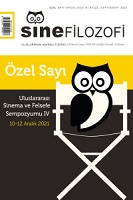Hareket İmajın Ötesine Geçmek Christopher Nolan Sineması
Going Beyond The Movement-Image: Christopher Nolan’s Cinematography
Author(s): İhsan Koluaçık, Azime CantaşSubject(s): Aesthetics, Structuralism and Post-Structuralism, Film / Cinema / Cinematography, Sociology of Art
Published by: Serdar Öztürk
Keywords: Nolan; Gilles Deleuze; The Movement-Image; Action-Image; The Time-Image;
Summary/Abstract: Gilles Deleuze describes the logic of the image as the technological automatons that he thinks of himself, by creating the unique thought image of each period. Philosophy, on the other hand, can map these images as thought-indicators when it is produced. Thus, the image, in its broadest sense, is defined as historically determined cinematic applications, “spiritual automatons” or “thought machines”. In this respect, the thought image of a period is the meaning of the thought it gives itself. While revealing the relationship between cinema and philosophy, the philosopher, who attaches great importance to cinema, deals with the ways of thinking represented as signs and images of a period and transforms them into philosophical concepts. Deleuze’s two-volume works titled Cinema 1: The Movement-Image and Cinema 2: The Time-Image” are important works in which cinema is evaluated with its unique tools. Deleuze, movies made before the Second World War, the movement-image; considers the films after the war as the time-image. Hence, he qualifies the movement image as classical cinema and the time-image as modern cinema. Deleuze states that neither the time-image originates from the movement-image nor that the time-image emerges as a criticism against the movement-image. According to him, this transition shows the transformation in the possibilities of thought and the nature of belief. In this context, the study will focus on Christopher Nolan’s cinema within the framework of Deleuze’s concepts of the movement-image, action-image crisis and the time-image. Within the scope of the study, Christopher Nolan’s mainly Follow (Takip, 1998), Memento (Akıl Defteri, 2000), Prestige (Prestij, 2006), The Dark Knight (Kara Şövalye, 2008), Inception (Başlangıç, 2010), Interstellar (Yıldızlararası, 2014), Tenet (Tenet, 2020).
Journal: SineFilozofi
- Issue Year: 7/2022
- Issue No: Sp. Iss.
- Page Range: 253-272
- Page Count: 20
- Language: Turkish

